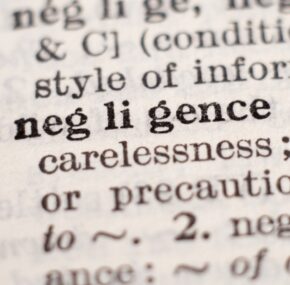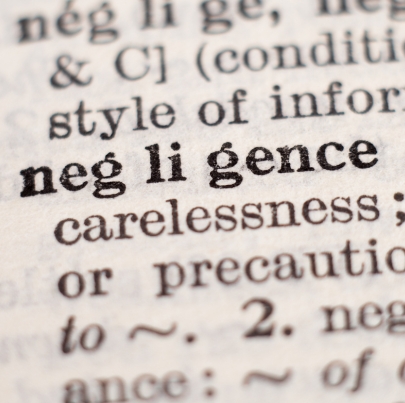Comparative negligence is a legal term that is used to determine fault when a car accident occurs between two or more drivers. Traffic collisions aren’t always straightforward, with responsibility for causing them falling to just one party. Knowing what comparative negligence is and how it applies to your situation can help you determine the best path forward.

Understanding Accident Liability Laws
When car accidents, slip-and-falls, and other types of accidents result in personal injuries, every state has its own laws that determine who’s at fault for the accident and who’s liable for the damages caused by that accident. Determining who is at fault for an accident is an important element in every personal injury case. Assigning fault usually determines which party will be held responsible for payment of related injuries and property damage.
In some accidents, the fault is fairly easy to determine. For example, if a driver runs a red light and hits a pedestrian who is legally crossing the street at a light or in a designated crosswalk. The driver will likely be determined to be the at-fault party.
In other situations, determining fault may not be so simple. For example, if two or more drivers are involved in a car accident, each driver may have contributed to resulting injuries and damages. When fault for an accident is shared, liability may be shared as well.
There are generally three types of accident liability laws that determine who is at fault for the accident and who is liable for the damages. When filing a personal injury claim, liability laws will vary from state to state, however, there are three types of basic liability laws that govern all personal injury cases:
- Comparative Negligence
- Modified Comparative Negligence
- Contributory Negligence
What Is Comparative Negligence?
Comparative negligence, also called comparative fault, is a legal term used in accident-based injury claims. It determines liability for the accident and for any damages resulting from the accident.
Comparative negligence is a partial legal defense that reduces the amount of damages that a plaintiff can recover in a negligence-based claim. It reduces damages based upon the degree to which the plaintiff’s own negligence contributed to the injury. A comparative negligence defense can be raised in any injury claim if the defendant feels like the injury victim (plaintiff) was partly responsible for causing his or her own harm.
To understand what comparative negligence is, you must first understand how it applies to fault for an accident and compensation for related injuries. When comparative negligence rules apply, injury victims can recover monetary damages from parties who caused them harm. However, their compensation will be reduced based on their own contribution to the accident.
Comparative Negligence Defenses
In personal injury cases, the injured party (the plaintiff) has the burden of proving that the at-fault party (the defendant) should be held liable for damages. The plaintiff can demonstrate this by proving 4 factors:
- Duty of Care – The defendant had a duty of care or obligation to act with a certain level of prudence. In some cases, a professional standard of care is used and the defendant’s actions are compared with what a similar professional would do. For example, in medical malpractice cases, the doctor’s actions are usually compared to what a similarly trained physician would have done.
- Breach of Duty – The defendant failed to act with a reasonable amount of care to prevent harm to the plaintiff.
- Breach of Duty Caused Injuries – The defendant’s breach of duty was the direct cause of the plaintiff’s injury.
- Injuries Resulted in Damages – The plaintiff sustained compensable damages due to the injuries caused by the defendant.
Once the plaintiff has met the burden of proof, the defendant is presumed liable, and he or she will be required to pay compensation for the plaintiff’s losses.
In personal injury cases, a comparative negligence defense is often used to reduce the amount the defendant must pay for damages. It is also used to prevent the plaintiff from recovering damages in states with modified comparative negligence laws if the plaintiff was more than 50% or 51% to blame for the accident.
Modified Comparative Negligence
Modified comparative negligence, also called modified comparative fault, is the most common type of liability law used in personal injury cases. It is used in 33 states across the country, including Illinois.
The damages collected by the victim are reduced by the victim’s percentage of liability. For example, if you are determined to be 20% responsible for a car accident that caused you to suffer injuries and damages totaling $250,000, your recovery for compensation will be reduced by 20%. You can only collect $200,000.
Modified comparative negligence laws allow the injured party to collect compensation for damages from another party, but only if the injured party’s degree of fault is under a certain threshold.
While comparative negligence lets you make a claim even if you’re up to 99% at fault for an accident, modified comparative negligence does not. Modified comparative negligence uses two threshold rules: a 50% rule and a 51% rule.
When there is a 50% threshold rule, you cannot collect compensation for damages if you’re 50% or more at fault for the accident. If your percentage of fault is equal to or greater than that of the other driver, you cannot file a personal injury claim against the other driver or the driver’s insurance company.
If there is a 51% threshold rule, you can’t collect compensation for damages if you are more than 50% at fault for the accident. In the event you’re 51% or more to blame for the accident, you’re out of luck.
Illinois is one of the majority of U.S. states to employ “at-fault” rules, also known as “tort liability” rules, for car accident claims. Drivers involved in Illinois car accidents who seek compensation must prove that the other party was at fault for the accident.
Illinois is a modified comparative negligence jurisdiction with a 51% threshold rule. If you’re injured in an Illinois car accident, you can only collect compensation for your injuries and property damages if you are below the 51% threshold for fault. When threshold rules apply, it’s essential to understand how these percentages will affect the outcome of your awarded damages.
Contributory vs. Comparative Negligence
Contributory negligence is the least common type of at-fault law used. It is used only in four states – Alabama, North Carolina, Maryland, and Virginia. Contributory negligence was the rule traditionally applied in tort cases, but many states have changed it because of so many unfair outcomes in personal injury cases.
While comparative negligence rules are based on percentages of fault for an accident, contributory negligence rules are not. When contributory negligence rules apply, a victim who is even partly at fault for causing his or her own injuries is barred from pursuing a legal claim for compensation. As such, if a person is only 1% responsible for an accident, he or she will be barred from obtaining monetary damages from a defendant who is up to 99% responsible for the accident. Because this type of negligence law offers little restitution for injury victims, it is not the law in the majority of states.
When contributory negligence applies, a defendant can completely avoid liability for losses if the plaintiff shares any responsibility for the harm that occurred. This rule is black-and-white, even when a defendant is 99% responsible for injuring the plaintiff. The plaintiff collects nothing if he or she is at fault in any way.
For example, if a drunk driver hits a pedestrian who is crossing the street in an unmarked crosswalk, the pedestrian is deemed not to be using reasonable care. Even though the driver is drunk, not acting reasonably in driving while drunk, and causing injury due to negligent actions, the pedestrian is not in a legal crosswalk, so legal actions by the pedestrian will be barred.
Personal Injury Claims
If you’re involved in an accident, it’s best to ask a car accident lawyer how you should proceed with an injury claim. Depending on the circumstances of your case and the severity of your injuries, you may want to file a personal injury lawsuit in court or settle your case outside of court through your lawyer.
Filing a Lawsuit in Court
If you are in a car accident, you may wonder about your legal rights and options. A personal injury lawsuit can provide financial compensation for the losses you’ve suffered, but it’s important to understand what will be required of you in a court trial.
Since a personal injury lawsuit is a civil action handled in court, you will need an injury lawyer who has trial experience with car accident claims and injuries. If your lawsuit is successful, you will receive compensation for your medical expenses, lost wages, and pain and suffering. To win a personal injury lawsuit, you must be able to prove that the person who caused your injuries (the defendant) is liable. You must prove the defendant is at-fault for the accident by negligent actions or other factors.
Some car accident cases become complicated, lengthy, and harder to prove because they have more than one defendant. Chain reaction car accidents are a common example of this. For example, if Driver A is speeding and can’t stop in time for a red light, he may hit your car as well as other cars, causing a pile-up accident and multiple injuries. If two or three drivers are at fault for your car accident, a percentage of responsibility will be assigned to each driver.
Personal injury lawsuits are governed by several laws, including statutes of limitations and state negligence laws. If you choose to file a lawsuit in court, you must file it within the statute of limitations. In Illinois, an injured party has two years from the date of the car accident to file a personal injury lawsuit, and five years to file for property damages. A pending insurance claim does not give you extra time to file a lawsuit, so it’s important to consult with a lawyer early to evaluate the strength of your claim.
Settling Your Case Out of Court
The vast majority of car accident cases are resolved through settlement negotiations between the injured party’s lawyer and the at-fault party’s insurance company. Only a small percentage of car accident cases ever proceed to a court trial. If you are in a car accident, it’s likely that your claim will end in a settlement. Car accident claims can often be favorably resolved without filing a lawsuit, which can be expensive and take months or even years to resolve in court.
It’s estimated that about 90% of civil cases reach settlements at some stage before going to trial. A settlement can be reached at any stage of the case, within the early weeks of filing to just days before the case is supposed to end.
When you negotiate a car accident settlement, the insurer for the at-fault driver generally agrees to pay you a set amount of money. In exchange, you release the insurer and the covered driver from any further liability.
A settlement can be a simpler and faster way to resolve your claim compared to a civil lawsuit, but you may receive a bigger payout by going to court. Insurance companies usually prefer to settle out of court. Doing so eliminates a costly court trial and the risk of an unexpected, large court verdict. Before you decide to file a lawsuit and go to trial or settle your case out of court, discuss the pros and cons with your lawyer, as well as comparative negligence, to ensure your best outcome.






